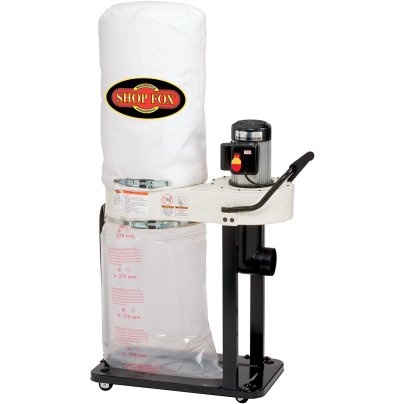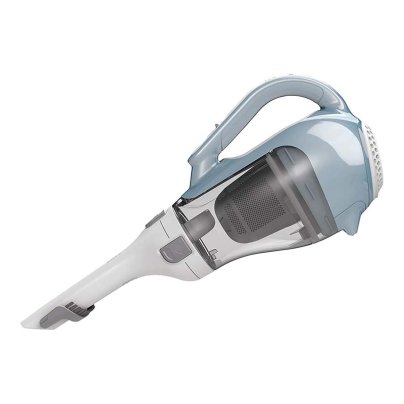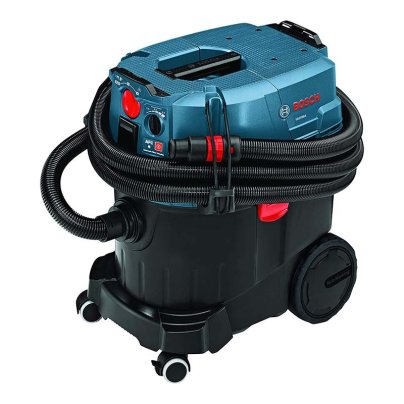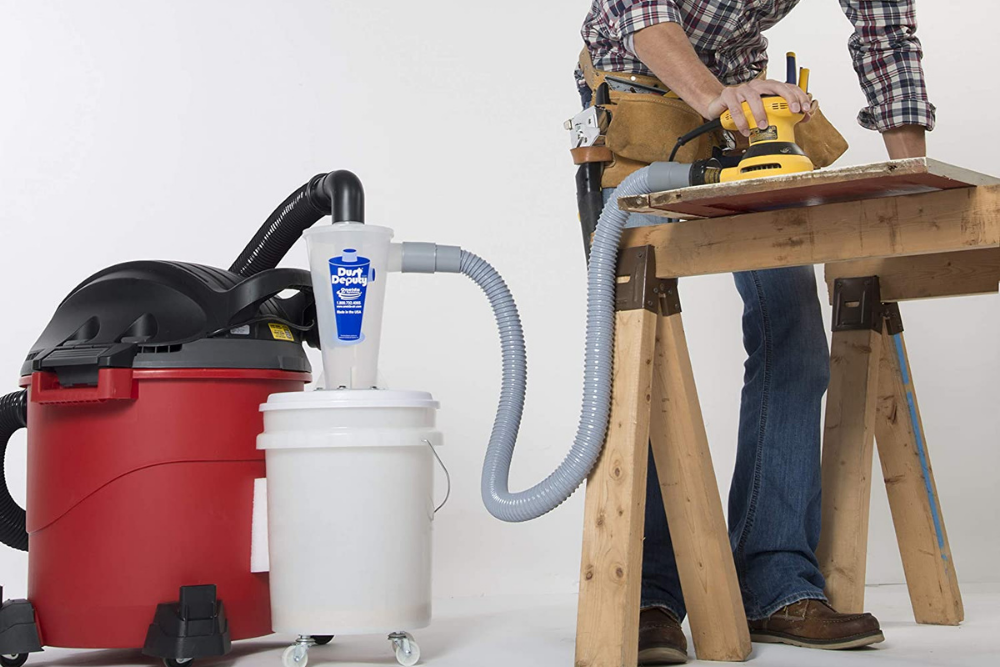
We may earn revenue from the products available on this page and participate in affiliate programs. Learn More ›
Wood and metalworking projects can range from entertaining hobbies to necessary professions, like carpentry and auto mechanic work. However, the one thing they have in common is the mess created by the fine dust produced while cutting, grinding, and sanding these materials. While the mess can be cleaned up after the project is complete, the fine dust can get everywhere, even obscuring the material while you work.
The answer to the problem is a dust collector. A dust-collection system connects to the power tools to provide consistent suction, pulling in any dust particles and debris created while working on the project. The best dust collector for your workshop depends on the size of the space, the amount of fine dust that is typically produced, and whether a portable dust collector or fixed dust collector would be better. Take a look at the top products listed below to get a better idea of possible dust-collection system options. Then keep reading to discover important product factors that can help you choose the best saw dust collector to keep the workshop clean.
- BEST OVERALL: Shop Fox W1727 — 1 HP 800 CFM Dust Collector
- BEST BANG FOR THE BUCK: Black+Decker CHV1410L Dustbuster Handheld Vacuum
- BEST FOR HOME: Bosch VAC090AH 9-Gallon Dust Extractor
- BEST HORSEPOWER: Shop Fox W1666 — 2 HP Dust Collector
- BEST WALL-MOUNTED: Powertec DC5371 Dust Collector With Filter Bag
- BEST FOR HAND TOOLS: DeWalt DWV010 Wet/Dry HEPA/RRP Dust Extractor
- BEST ROOM FILTRATION: Wen 3410 Remote-Controlled Air Filtration System
- BEST CORDLESS EXTRACTOR: Makita XCV11T Cordless Dust Extractor/Vacuum Kit
- BEST DUST SEPARATOR: Oneida Air Systems Dust Deputy 5-Gallon Separator
- BEST FOR WOODWORKING: Rousseau Model 5000 Dust Solution for Miter Saws
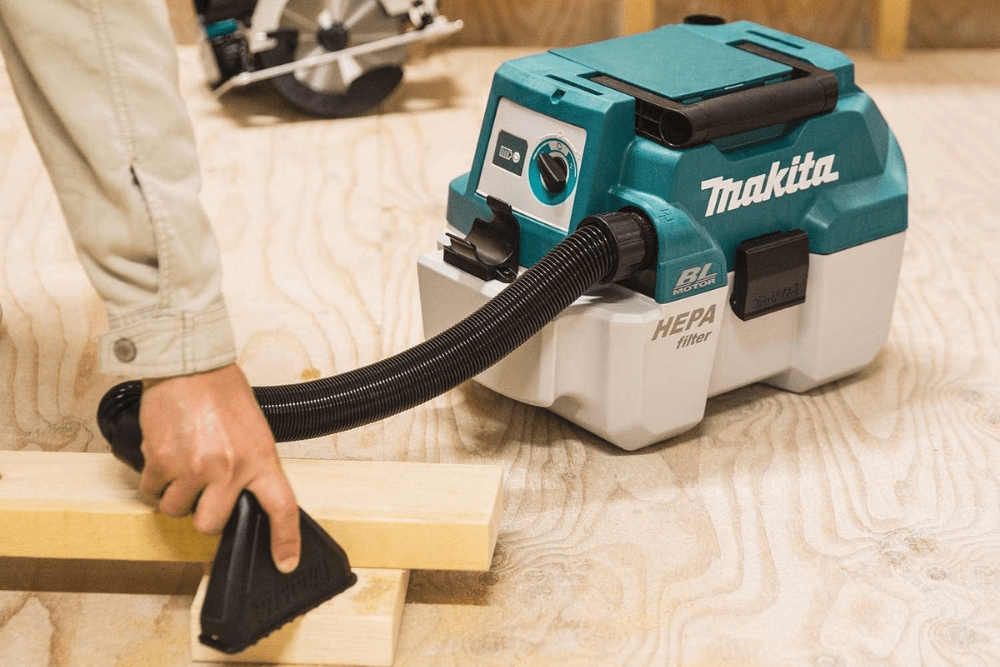
How We Chose the Best Dust Collectors
There are many different features to consider when selecting the best dust collectors, but the main factors that were explored during extensive product research include the dust collector type, product suitability, horsepower, air suction power, filter efficiency, and functionality. The dust collector type was important to incorporate because not every type of dust collector is suited to every user.
The product type is also affected by the suitability and functionality of the product. For instance, not all listed products are dust collectors, but every product on the list can be used to make dust collection easier, such as the Rousseau 5000 Dust Solution. It’s almost useless on its own, but when paired with a shop vac or dust collector, it makes it much easier to keep the work area of a miter or table saw clean, despite the typical spray of sawdust.
Horsepower (hp), air suction power, and filter efficiency were top considerations while researching these products because these specifications greatly affect the dust-collection ability of the dust collector and provide measurable information to help make comparisons between products.
Our Top Picks
The top products below include several types of dust collectors selected based on dust-collection capacity, motor power, suction, filter efficiency, and overall value to help find the best dust collector for keeping the workshop clean.
Best Overall
Shop Fox W1727 — 1 HP 800 CFM Dust Collector
Pros
- Built-in safety switch reduces the chance of accidental activation
- High air-suction power improves cleaning potential and device efficiency
- Included handle and wheels for easy portability in and out of the workshop
Cons
- Must be adapted to a 2.5-inch hose for small tools
Product Specs
- Horsepower: 1 hp
- Air-suction power: 800 cubic feet per minute (CFM)
- Filter efficiency: 2.5 microns
This bag dust-collection system from Shop Fox helps to keep users safe with a built-in safety switch that must be operated with a removable key. The 1-hp motor provides enough power to generate up to 800 CFM of air-suction power, making it easy to
keep the work area clean while sanding
, grinding, or cutting. When the dust and debris are pulled into the dust collector, pieces of wood or metal larger than 2.5 microns are trapped in the dust separator filter and dropped into the 2.1-cubic-foot dust-collection bag.
The combination of high air-suction power, good air-filter efficiency, and voluminous dust-collection bag are primary contributors to the success of this product. It even has built-in handles and wheels to improve the portability and offset the 59-pound weight. However, the 4-inch hose outlets need to be adapted to a 2.5-inch hose for use with smaller tools.
Get the Shop Fox W1727 dust collector at Amazon, The Home Depot, or Acme Tools.
Best Bang for the Buck
Black+Decker CHV1410L Dustbuster Handheld Vacuum
Pros
- Built-in accessory tools for enhanced cleaning reach and maneuverability
- Washable dirt bowl and filter reduces spending on disposable filters
- Cordless handheld design makes it easy to handle messes anywhere in the home
Cons
- Low power output reduces the overall cleaning potential of the product
- Low air-suction power may struggle to collect bigger pieces of wood
- Cannot connect to power tools for direct suction of dirt and debris
Product Specs
- Air-suction power: 20 air watts
- Cordless vs. corded: Cordless
- Nozzle: 180-degree rotation
While this affordable handheld vacuum cannot connect directly to any power tools, it is a lightweight, cordless option that makes cleaning up a small sawdust or metal dust mess simple. The cordless vacuum has a 0.1-hp motor and produces up to 100 cubic feet per minute of air suction power as well as a washable filter that can catch debris and particles larger than 5 microns.
Make use of the built-in accessory tools, including a flip-up brush, an extendable crevice tool, and a rotating nozzle, to clean dust and debris from tough-to-reach places, like behind the workbench. The cyclonic action of the vacuum acts as a dust separator to separate large debris from small particles to help prevent clogs in the system.
Get the Black+Decker dust collector at Amazon, Lowe’s, The Home Depot, Wayfair, or Walmart.
Best for Home
Bosch VAC090AH 9-Gallon Dust Extractor
Pros
- Modest 150 CFM air-suction power is well suited for cleaning up around the home
- Impressive 0.3-micron filtration system captures up to 99.97 percent of dust particles
- Automatic filter cleaning system cleans the filter every 15 seconds for optimal power
Cons
- The air-suction power to motor-power ratio is relatively low, reducing cleaning potential
Product Specs
- Horsepower: 1.5 hp
- Air-suction power: 150 CFM
- Filter efficiency: 0.3 microns
Fixed dust-collection systems are ideal for frequently used workshops, but for those that only tackle a woodworking project a few times through the year, a fixed dust-collection system largely goes unused. With this Bosch dust extractor, users can clean up quickly after a woodworking job and then wheel it into the home on its four durable wheels. Once inside, the dust extractor can operate as a vacuum to keep the bedroom, living room, dining room, and other areas of the home free of dust and dirt.
Airborne debris can make it more difficult to enjoy peaceful sleep, but with the 0.3-micron filtration system, this dust extractor can capture up to 99.97 percent of dust particles to ensure the bedroom air is easy to breathe. This dust collector also boasts an automatic filter cleaning system that will clean the air filter about once every 15 seconds to reduce the strain caused by a clogged filter. Just keep in mind that this mobile device may not have the air-suction power to motor-power ratio of more heavy-duty dust collectors.
Get the Bosch dust collector at Amazon, Lowe’s, The Home Depot, Acme Tools, or Bosch.
Best Horsepower
Shop Fox W1666 — 2 HP Dust Collector
Pros
- 2-hp motor provides the power necessary to produce up to 1,550 CFM
- Powerful air-suction output quickly collects dust, dirt, and debris
- Large 5-cubic-foot dust-collection capacity fills up slowly, requiring less frequent emptying
Cons
- Difficult to move without more than 1 person at 108 pounds
Product Specs
- Horsepower: 2 hp
- Air-suction power: 1,550 CFM
- Filter efficiency: 2.5 microns
The Shop Fox W1666 dust collector isn’t the best choice for a small workshop because it weighs about 108 pounds, is difficult to move around, and takes up about 5 square feet of floor space. However, for medium- to large-size workshops, this powerful 2-hp bag dust collector is a great addition that comes with two 4-inch hose outlets that can be used at the same time.
It’s an impressive product with a 2.5-micron filter efficiency and 1,550 CFM air-suction power that quickly pulls in dust and debris for storage in the 5.4-cubic-foot dust-collection bag. Unfortunately, all this power and dust-collection potential comes at a higher price than a smaller product, so it’s important to figure out if this amount of air-suction power is necessary before deciding on this bag dust collector.
Get the Shop Fox W1666 dust collector at Amazon, The Home Depot, Northern Tool + Equipment, or Acme Tools.
Best Wall-Mounted
Powertec DC5371 Dust Collector With Filter Bag
Pros
- Wall mount saves floor space in small or cramped workshops
- The dual-voltage motor can be connected to 120-volt or 240-volt systems
- Safety on/off switch to prevent accidental misuse or activation
Cons
- Must be adapted to a 2.5-inch hose for small tools
- Heavy to lift, maneuver, and mount at a weight of 52 pounds
Product Specs
- Horsepower: 1 hp
- Air-suction power: 560 CFM
- Filter efficiency: 1 microns
Small but busy workshops can benefit from having a wall-mounted dust collector like this impressive product from Powertec. The dust collector has 560 CFM suction power and a 1-micron filter-efficiency rating. The wall mount ensures the dust collector remains off the floor, giving users more space to move or store items. Just secure the dust collector to the wall with the included wall-mount brackets, then use the hose to suction up dust and debris from the project or material.
A built-in window on the dust-collection bag makes it easy to see when the bag is full, and the safety on/off switch helps to prevent accidents. This dust collector weighs 35.5 pounds, and it has a 4-inch hose that would need to be adapted to 2.5 inches for smaller tools. The machine runs on a 1-hp dual-voltage motor, allowing it to be used on either 120-volt or 240-volt power systems.
Get the Powertec dust collector at Amazon or The Home Depot.
Best for Hand Tools
DeWalt DWV010 Wet/Dry HEPA/RRP Dust Extractor
Pros
- Built-in wheels for easy portability across flat surfaces and floors
- Long 15-foot hose for maneuverability around objects or woodworking tools
- Can be equipped with high-efficiency 0.3-micron HEPA filtration
- Large 8-gallon dust-collection capacity reduces tank-emptying frequency
Cons
- Low air-suction power to motor-power ratio reduces cleaning potential
Product Specs
- Horsepower: 1.875 hp
- Air-suction power: 150 CFM
- Filter efficiency: 0.3 microns (DWV9330 filter)
Keeping any project neat and clean while working is an important step that can mean the difference between an ideal outcome and a botched result. If the user cannot see their work material, achieving the desired look or appearance becomes increasingly difficult. The DeWalt dust extractor connects directly to small power tools to clean up dust as soon as it’s created.
The nearly 2-hp motor provides a significant amount of power to the tool, though despite this high power output, the air-suction power is just 150 CFM. However, 150 CFM is more than enough to handle the small volume of dust that is typically created by small hand tools, and the 0.3-micron HEPA filter helps to ensure that the dust extractor doesn’t clog.
Get the DeWalt dust collector at Amazon, The Home Depot, or Acme Tools.
Best Room Filtration
Wen 3410 Remote-Controlled Air Filtration System
Pros
- Passive air filtration automatically pulls dust particles out of the air
- Quiet 50-decibel operation is safe for use in an enclosed workshop
- Remote-controlled functionality allows users to operate the system across the room
Cons
- Cannot be connected to power tools for direct suction and cleanup
- May take several hours to filter the air with passive filtration
Product Specs
- Horsepower: 0.17 hp
- Air-suction power: 300, 350, or 400 CFM
- Filter efficiency: 1-micron or 5-micron
The Wen air filtration system is a whole-room filter that can be installed on the roof of a garage or workshop using the included hooks. Once in place, it can operate at three different air-suction powers, including 300, 350, and 400 CFM, according to the user’s preference. Use the included remote control to set the air-suction power, turn the air-filtration system on or off, and even set a programmable timer to shut the system off after the scheduled period of time.
While this product cannot be connected directly to power tools, it passively pulls air through the 1-micron or 5-micron filter, trapping any dust and debris to clean the air within the room. The air-filtration system has a 0.17-hp motor and operates at just 50 decibels, so the sound is about as loud as a regular conversation.
Get the Wen dust collector at Amazon, Lowe’s, The Home Depot, or Wen.
Best Cordless Extractor
Makita XCV11T Cordless Dust Extractor/Vacuum Kit
Pros
- High filter efficiency of just 0.3 microns to filter out large particles
- Lightweight design and built-in handle make it easy to carry
- Multiple speed settings help improve user control and dust cleanup
Cons
- Low horsepower output limits the dust- and debris-cleaning ability
- Weak suction power throttles the speed and reduces the device’s effectiveness
Product Specs
- Horsepower: N/A
- Air-suction power: 57 CFM
- Filter efficiency: 0.3 micron
This cordless dust extractor weighs just 10 pounds, and it has a foldaway handle as well as a hose storage space, making it easy to pick up and carry around the workshop or even load into a car or truck to take to the jobsite. The battery lasts for up to 60 minutes of continuous runtime when equipped with one of the two included 18-volt batteries. Each battery takes about 45 minutes to charge, so while one battery is in use, the other battery can fully charge.
The Makita cordless dust extractor has a highly efficient high-efficiency particulate air (HEPA) filter that captures dust and debris larger than 0.3 microns. However, the dust extractor is limited by the low power output of just 0.1 hp and the 57-CFM air-suction power, so it isn’t the best option for a busy workshop.
Get the Makita dust collector at Amazon, The Home Depot, or Acme Tools.
Best Dust Separator
Oneida Air Systems Dust Deputy 5- Gallon Separator
Pros
- Simple design that makes it easy to learn and use
- Effectively removes and separates large debris before it reaches the filter
- Use with a wide range of dust extractors and collectors
Cons
- Must be used with another dust collector or vacuum for suction
- Doesn’t have its own filter, but it functions as one
- Top-heavy design of the separator can be susceptible to tipping
Product Specs
- Horsepower: Reliant on the power output of the standard shop vac that’s connected to it
- Air-suction power: Determined by the connected shop vac or dust collector
- Filter efficiency: Does not have a filter; only acts as a filter to remove and collect large debris
Small workshops don’t often need to use a full bag or bucket dust collector because, typically, only one person is using tools at a time. These work spaces benefit from a heavy-duty shop vac that can be quickly wheeled or carried over to where the user is working. Use this Oneida cyclonic dust separator to pull large debris into one of two 5-gallon dust-collection buckets to avoid clogging the shop vac with wood chips or metal splinters too big to pass through the filter.
Simply connect the shop vac or dust-collector hose to the cyclonic dust separator and connect the included hose to the power tool in use. The dust will be pulled in from the power tools and filtered through the cyclonic chamber, which separates large pieces of debris from smaller particles. The large pieces fall into the collection bucket, while the smaller particles pass through the hose and into the shop vac or dust collector.
Get the Oneida Air Systems dust collector at Amazon.
Best for Woodworking
Rousseau Model 5000 Dust Solution for Miter Saws
Pros
- Easy to use and set up with a miter saw
- Dust solution folds up for compact storage when not in use
- Designed to capture dust generated by miter saws and chop saws
Cons
- Cannot be used effectively without another dust collector or shop vac
- Not equipped with a filtration system to filter fine dust particles
- Not suitable for tools other than miter or chop saws
Product Specs
- Horsepower: Can be used with any shop vac or dust collector that has a 4-inch vacuum hose
- Air-suction power: Only provides an area to collect the dust; suction power determined by the shop vac or dust collector that’s connected
- Filter efficiency: Not equipped with a filter
While not technically a dust collector, this Rousseau dust-collection system is an ideal solution for the mess that miter saws and chop saws can create when used for woodworking projects. It consists of a hood that sits over about half of the saw—without interfering with the movement of the blade—to trap any dust that is produced. However, the dust-collection system doesn’t have any suction power on its own, so for it to be effective, a shop vacuum or dust collector needs to be connected to the 4-inch vacuum port to provide continuous suction for woodworking jobs.
The hood is compact and easy to set up or fold down for simple storage, but a limitation of this dust-collection system is that the hooded design isn’t suitable for all power tools. In fact, it’s best if this tool is reserved for woodworking with miter and chop saws.
Get the Rousseau dust collector at Amazon or Rousseau Co.
Jump to Our Top Picks
What to Consider When Choosing a Dust Collector
With the various dust-collector types in mind, it’s easier to understand the important factors that can affect the choice of a dust collector for the workshop. Before deciding on the best dust collector, consider the size of the workshop, dust-collection capacity, motor power, suction, and whether a fixed or portable dust collector is better for keeping the workshop clean, in addition to several additional elements outlined below.
Types of Dust Collectors
Dust collectors are typically grouped based on dust-collection capacity, portability, and power. These types include standard shop vacuums, dust extractors, single-stage bag dust collectors, canister dust collectors, and cyclonic dust collectors.
- Standard shop vacuums come with hoses that can attach to dust-collection outlets on some power tools, though adding a dust separator to a shop vacuum helps to improve the dust-collection suction and reduce clogging.
- Dust extractors are essentially a specialized type of shop vacuum that is only made for use with small hand tools.
- Bag dust collectors are a step up from shop vacuums. They have a higher power output and can connect to multiple tools, making them ideal for small yet busy workshops. Some bag dust collectors even have a wall mount to reduce the amount of floor space taken up by the device.
- Canister dust collectors are similar to bag dust collectors in that they can connect to multiple tools, but these dust collectors have a cartridge system that is better at capturing 1- and 2-micron dust particles.
- Cyclonic dust collectors are also referred to as two-stage dust collectors because they use cyclonic action to separate smaller dust particles from larger pieces of debris. The larger pieces fall into a central collection chamber, while the smaller particles are pulled through a fine filter to help capture as much dust as possible.
Size of Workshop
Before selecting a dust collector based entirely on power, it’s necessary to consider the size of the workshop. Some dust collectors, like standard shop vacuums and dust extractors, can be used in just about any workshop because they are small and portable. However, these products may be ineffective options for a workshop with multiple users because they can only connect to one tool at a time.
Larger workshops benefit from bag and canister dust collectors because they can be set up in a central location to collect the dust from multiple tools simultaneously. These systems, however, aren’t the best choice for smaller workshops because they take up too much floor space. A wall-mounted bag dust collector may be the best option for a busy yet small workshop because it doesn’t take up any floor space, yet it can still connect to more than one tool.
Dust-Collection Capacity
The amount of dust that is regularly collected, as well as the frequency with which the dust collector is emptied, are two factors that can affect the decision when it comes to dust collectors. While these tools are made for collecting dust, they still have a finite amount of debris that the bag or canister can hold. This is referred to as the dust-collection capacity.
For large workshops that regularly produce a high amount of dust and debris, it is best to opt for a dust collector with a dust-collection capacity of at least 5 cubic feet. Smaller workshops or small hand tools can use smaller bags or canisters, though they need to be emptied more frequently.
Motor Power and Suction
The power output and air-suction potential are determined by the motor’s horsepower and the volume of air that the dust collector can move, measured in cubic feet per minute. Motor power is measured in hp, and dust-collector motors typically fall between 0.5 and 1.5 hp, though some products have motors that exceed 3 hp.
The dust collector’s air volume or suction ability can be about 100 to 150 CFM for shop vacs and dust extractors, but typically a dust collector will have about 400 to 500 CFM. However, busy workshops may require a dust collector with an air-suction power rating of 1,000 CFM or higher to adequately provide suction power to multiple tools at once.
Fixed vs. Portable
Dust collectors come in several different types based on motor power, suction ability, and dust-collection system, but these tools can also be separated by their portability. Typically, a dust collector is a portable tool that is either light enough to carry or it has a wheeled base or frame that can be used to move the tool around the workshop. However, this style of dust collector takes up floor space and can become a tripping hazard.
Mounted or fixed dust collectors are installed on the wall or ceiling to help save space in a crowded workshop. Just connect the hoses to the dust collector and turn it on to start cleaning up the work space. However, it’s important to keep in mind that the longer the hose, the less suction power the dust collector will have, so it’s a good idea to mount the dust collector in a central location.
Filter Efficiency
Filter efficiency refers to the ability of the dust collector’s filter to stop dust and other contaminants from passing through. By trapping large debris and dust particles in the filter, the dust collector can continue to work at a high level of suction power without the user having to worry about clogs.
Filter efficiency is typically measured by the minimum size of particle the filter can capture, or the absolute micron rating. For instance, a high-efficiency filter may have an absolute micron rating of 1 micron, indicating that it will stop particles and debris larger than 1 micron at least 95 percent of the time. The average dust-collector filter will have an absolute micron rating of about 2.5 microns.
Additional Features
Many manufacturers include features that are not strictly necessary for the dust collector to function, but they help increase product efficacy and improve the dust-collector design. Some examples include remote controls, noise-reducing insulation, handles, wheels, and hose storage spaces.
- Remote controls are ideal for fixed or mounted dust collectors. This is because a remote control can be used to control the dust collector from a distance, so the user doesn’t need to walk across the workshop to turn on or off the device.
- Noise-reducing insulation helps to reduce the amount of sound the motor makes while the dust collector is in operation.
- Handles and wheels are used to help increase the portability of a dust collector. They make it easier to move the dust collector around on a flat surface and pick it up.
- Hose and hose attachment storage spaces help to keep the workshop neat and tidy after the dust has been cleaned up. These are typically located on the side or top of the dust collector.
FAQs
After taking the time to learn about the top considerations for choosing a new dust collector, you may still have some lingering questions about the noise level, power, and even the functionality of a dust collector. Keep reading for answers to these and several other frequently asked questions that are addressed below.
Q.Is a dust collector better than a shop vac?
Both dust collectors and shop vacs are intended to help keep the workshop clean, but dust collectors typically have a higher suction, making them better for quickly cleaning up fine dust and debris. However, shop vacuums provide increased mobility and easy portability, so whether a dust collector is better than a shop vac depends on your needs.
Q.How powerful of a dust collector do I need?
To keep an entire workshop clean, it’s recommended to invest in a large dust collector with an air-suction rating between 200 to 1,000 CFM. However, less powerful dust collectors and small, handheld vacuums can effectively clean up small messes without needing to connect long, bulky hoses. Consider the size of the space, frequency of use, and amount of dust typically produced to decide on the best power output for your dust collector.
Q. What does a dust collector do?
A dust collector does exactly as indicated by the name: It collects dust. These devices connect to your power tools in order to provide active suction while you work. This cleans up the dust as it’s produced, ensuring that you can see the project at all times and keeping the workshop clean in the process.
Q. What is the best dust collector?
The best dust collector for your workshop depends on a range of factors, including workshop size, dust-collection capacity, and power output, so the best dust collector for one person may not be the best for someone with a different setup. However, the Shop Fox W1727 dust collector is one of the best options available.
Q. Are dust collectors loud?
On average, dust collectors produce about 50 to 65 decibels of sound, depending on the size of the motor. To put this in perspective, a regular conversation is about the same noise level.
Q. How far can a dust collector work?
The maximum length of the hose with which the dust collector can continue to work effectively is determined by the power output and air-suction power of the tool. On average, a 2-hp dust collector can be used with up to 25 feet of hose, but a 1-hp dust collector is only powerful enough for about 15 feet of hose. Also, keep in mind that any bends in the hose will reduce the suction power of the dust collector.
